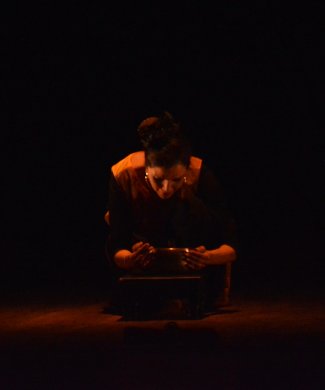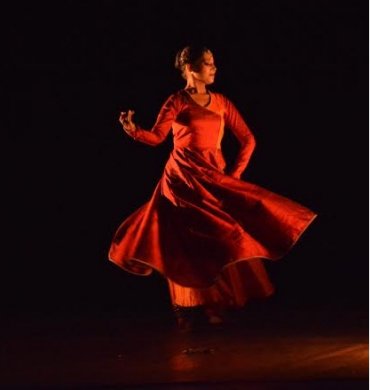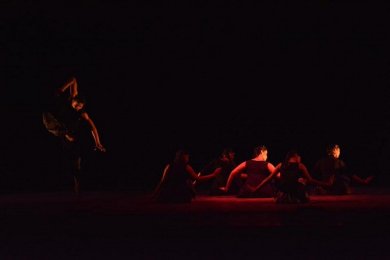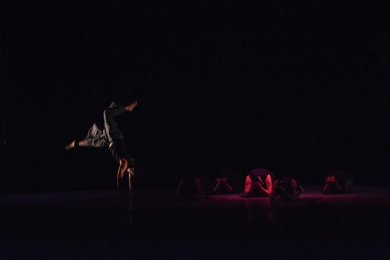
|   |

|   |
 e-mail: ukb7@rediffmail.com Tremors from borderlands Photos courtesy: Rhythmosaic November 15, 2016 There are many barriers in our human civilization that are constantly crying out to be crossed. At one level, there are mortals who have well-defined genders and there are less fortunate ones whose genders are blurred. At another level, there are forms of cultural expressions -- like dance - which get defined by the ethos from which they have evolved and vary hugely from one land to the other. Quite often, these boundaries get so ossified that they get mistaken for God's own handiwork or culturally too sacrosanct to be ever broken.  Prism  Desolate Rhythmosaic made recently in Kolkata a praiseworthy effort to touch upon a few such shibboleths with their trans-border implications and launched what could be termed a full-blooded attack and not just a surgical strike. The assault was spearheaded by Anita Ratnam - a perennial favourite on both sides of the Vindhyas -- with her new creation, Prism. This was a solo piece on the Tibetan Vajrayana goddess Tara who is aptly contemplated upon across borders: beginning from the Asian peninsula and extended up to the Pharaoh's land on the Nile, and whose many manifestations in green, white, red, black, yellow and blue literally cover variegated qualities like enlightenment, compassion, ferocity, power prosperity and anger, in that order. Anita's measured steps built upon a deliberative geometry: with the locus fixed on a prayer-bowl and its striking stick. Her entire focus, her movement patterns, her meditative mood remained mesmerizing. Arangham Dance Theatre from Chennai next presented Padme with a band of highly-trained youthful dancers, five female and one male, in a well-knit teamwork. Under Anita Ratnam's baton, they took up the metaphor of lotus and explored the boundaries between the gravity-defined Indian classical dance at one end and the gravity-defying Western contemporary dance at the other, by coalescing and intersecting with each other, mixing and mirroring their experiences in all possible manners. The leaping steps merged into the Bharatanatyam adavus, the bold Kalaripayattu gestures melted into women's supple bodies and the balletic extensions from solar plexus transfixed the alapadma mudras that prevailed all through. Of particular fascination was the long 7-beat rhythmic narrative that was embedded into swaying torsos, undulating legs and group formations that formed and dissolved almost instantly. 

Padme
In the finale, Rhythmosaic Sengupta Dance Company from Kolkata presented Desolate - The Voices of the Trapped. It was a heroic effort to obliterate borderlines between the so-called normal beings and the trans-sexual and trans-gender person (khusras), the cross-dresser (zenanas), the eunuch (narnbans) and, in effect, all those who feel entrapped in a body alien to his/her comfortable gender. The third gender has a recorded history in the Indian subcontinent from antiquity onwards as suggested by the Kama Sutra and features a number of well-known roles within sub-continental cultures: part gender-liminal, part spiritual and part survival. Directed by Mitul Sengupta, the group of male and female dancers - led by Mitul herself as Aravan - enacted the Mahabharata story, where before the Kurukshetra War, Aravan offers his life-blood to goddess Kali to ensure the victory of the Pandavas, and Kali agrees to grant him power. On the night before the battle, Aravan expresses a desire to get married before he dies. No woman was willing to marry a man doomed to die in a few hours, so Arjuna as Brihannala marries him. In the performance, Mitul excelled in her chakradhars and tatkars, both with and without anklets. The rest of the company was very supportive and choreographed echoes almost wailed from the deep within: "We are trapped, marginalized and utterly desolate."  Dr. Utpal K Banerjee is a scholar-commentator on performing arts over last four decades. He has authored 23 books on Indian art and culture, and 10 on Tagore studies. He served IGNCA as National Project Director, was a Tagore Research Scholar and is recipient of Padma Shri. Post your comments Please provide your name and email id when you use the Anonymous profile in the blog to post a comment. All appropriate comments posted with name & email id in the blog will also be featured in the site. |